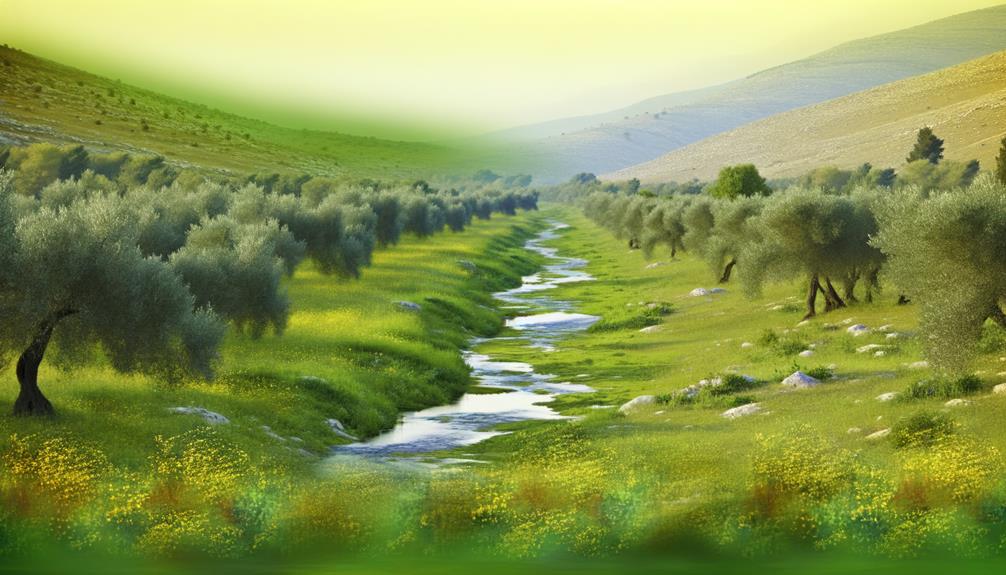Brooks Meaning in the Bible: Life, Provision
In the Bible, brooks symbolize divine provision and spiritual refreshment, illustrating God’s nurturing care during moments of need. Historically crucial, brooks like the Brook Cherith (1 Kings 17:3-6) sustained Elijah during a drought, showcasing God’s miraculous provision.
They evoke a deep yearning for God, as depicted in Psalm 42:1, and are metaphors for spiritual renewal. In the context of the Promised Land, brooks signify fertility and the fulfillment of God’s promises.
The imagery of flowing streams represents tranquility and the transformative power of divine grace, underscoring spiritual nourishment essential for a thriving faith journey. Discover more about these profound symbols and their significance.

Brooks Meaning in the Bible: Symbolism of Refreshing and Divine Provision
| Aspect | Details |
|---|---|
| Definition | Small streams of water, often representing life, sustenance, and blessings |
| Key Bible Reference | Elijah at the brook Cherith (1 Kings 17:3-6) |
| Symbolic Meaning | Renewal, provision, peace, and the presence of God |
| Spiritual Insight | God provides spiritual refreshment in dry seasons of life |
| Moral Lesson | Trust in God’s provision even when resources seem small or hidden |
Symbolism of Brooks

In biblical literature, brooks often symbolize divine provision, spiritual refreshment, and the sustenance of life. Theological insight recognizes brooks as metaphors for God’s nurturing presence and His provision in times of need.
Historically, brooks provided essential water sources in arid regions, making them indispensable for survival and prosperity. Scriptural analysis reveals that these natural elements frequently serve as settings for divine encounters and blessings.
For instance, brooks are depicted as places where prophets receive sustenance, as seen in the story of Elijah. This consistent imagery underscores God’s role as the ultimate provider and sustainer.
Consequently, brooks in biblical texts evoke a profound understanding of spiritual nourishment and the omnipresence of divine care in the believer’s journey.
Brooks in the Old Testament

In the Old Scriptures, brooks are frequently depicted as essential sources of water, symbolizing God’s provision in times of need, as seen in Elijah’s sustenance by the Brook Cherith (1 Kings 17:3-6).
These watercourses not only provided physical nourishment but also served as metaphors for spiritual refreshment and renewal, as reflected in the Psalms (Psalm 42:1).
The theological significance of brooks underscores God’s ongoing care and the sustenance He offers to His people amidst their wilderness experiences.
Symbolic Water Sources
Brooks in the Old Scriptures often serve as symbolic water sources that reflect divine provision, spiritual nourishment, and moments of God’s intervention in the lives of His people.
In the arid landscapes of the ancient Near East, brooks and streams signified life and sustenance. For example, in 1 Kings 17:3-4, the brook Cherith provided Elijah with water during a severe drought, symbolizing God’s care in times of need.
Similarly, Psalm 42:1 likens a soul’s longing for God to a deer panting for water from a brook, illustrating deep spiritual thirst.
These scriptural instances underscore brooks as metaphors for God’s enduring presence and support, offering believers reassurance of His unceasing provision and nurturing power.
God’s Provision Miracles
God’s provision miracles in the Old Scriptures often manifest through brooks, as seen in the story of Elijah at the brook Cherith, where divine sustenance was provided through both water and ravens. This narrative illustrates God’s intervention during times of need, reaffirming His omnipotence and care for His prophets.
Theologically, the brook symbolizes God’s provision and faithfulness, while historically, it underscores the reliance of ancient peoples on natural water sources for survival. Scriptural analysis reveals that such instances are emblematic of divine care in seemingly desolate circumstances.
| Aspect | Example |
|---|---|
| Location | Brook Cherith |
| Recipient | Elijah |
| Source of Water | Natural brook |
| Additional Provision | Ravens providing food |
| Scriptural Reference | 1 Kings 17:2-6 |
Spiritual Refreshment Metaphors
Throughout the Old Scripture, brooks frequently serve as potent metaphors for spiritual refreshment, symbolizing the renewal and sustenance provided by divine intervention in the lives of the faithful. These flowing waters are often depicted as lifelines in arid landscapes, emphasizing the necessity of divine grace for spiritual energy.
The imagery of brooks conveys:
- Psalm 42:1: ‘As the deer pants for streams of water, so my soul pants for you, my God.’
- Isaiah 35:6: ‘Water will gush forth in the wilderness and streams in the desert.’
In this way, brooks serve as vivid illustrations of God’s unending provision and the spiritual nourishment essential for believers.
Divine Sustenance

In exploring the concept of divine sustenance, we find that biblical brooks frequently symbolize God’s provision and care for His people.
Throughout scripture, brooks serve as tangible evidence of divine benevolence, such as in 1 Kings 17:2-6, where the brook Cherith sustains Elijah during a drought.
Historically, these brooks were essential for survival in arid regions, reflecting God’s ability to meet physical needs.
Theologically, they illustrate God’s ongoing commitment to nurturing His followers, offering a source of life and refreshment.
Psalm 23:2 encapsulates this by leading the faithful beside ‘still waters,’ emphasizing tranquility and divine care.
Consequently, brooks in the Bible underscore a deeper understanding of God’s sustaining power and faithfulness.
Brooks as Metaphors

Brooks in the Bible often serve as profound metaphors for spiritual renewal, guidance, and the flow of divine grace. These streams symbolize God’s ever-present sustenance and refreshment for His people, often illustrating deeper spiritual truths through vivid imagery.
- Flowing waters: Represent the continuous and life-giving presence of God’s Spirit, as seen in Psalm 42:1, where the psalmist’s soul longs for God like a deer pants for brooks of water.
- Seasonal brooks: Reflect the temporality and variability of human faith, akin to Job 6:15-17, where friends are likened to unreliable brooks that vanish.
These metaphors enrich our understanding of divine realities.
Promised Land Brooks

In the biblical narrative, brooks in the Promised Land are depicted as abundant water sources that signify God’s provision and faithfulness to His people.
Historically, these brooks underscore the fertility and sustenance of the land promised to the Israelites, reinforcing the idea of divine blessing.
Scripturally, they symbolize spiritual nourishment and the fulfillment of God’s covenant, echoing themes of renewal and hope throughout the biblical text.
Abundant Water Sources
As the Israelites journeyed towards the Promised Land, the presence of brooks symbolized God’s provision of abundant and life-sustaining water sources, underscoring His commitment to their well-being and prosperity.
These brooks, often mentioned in the Old Scripture, served as vivid reminders of God’s promises and faithfulness. The following imagery from scripture helps us grasp the significance of these brooks:
- Flowing Streams: Representing continuous divine sustenance.
- Verdant Valleys: Symbolizing fertility and the promise of a bountiful land.
Historically, these water sources signified a stark contrast to the arid desert they traversed, reaffirming God’s covenant to lead them to a land ‘flowing with milk and honey’ (Exodus 3:8).
Symbolic Significance Explained
While many physical features of the landscape held practical importance, the brooks of the Promised Land carried profound symbolic significance, representing divine provision, spiritual renewal, and the fulfillment of God’s covenant with His people.
Scripturally, brooks are depicted as sources of life and sustenance, often mentioned in conjunction with God’s blessings (Deuteronomy 8:7).
Historically, they provided essential water in an arid region, symbolizing God’s care and faithfulness.
Theologically, these brooks are emblematic of spiritual abundance, as seen in Psalm 1:3, where the righteous are likened to a tree planted by streams of water.
This imagery underscores the necessity of divine sustenance for spiritual growth and the realization of God’s promises to Israel.
Spiritual Refreshment

The imagery of brooks in the Bible often symbolizes a source of spiritual refreshment, drawing a parallel to the rejuvenating presence of God in the lives of believers.
Historically, brooks provided essential water in arid regions, representing sustenance and renewal. Scripturally, references such as Psalm 42:1 evoke a deep yearning for God, akin to a deer panting for water.
- Cool, flowing streams: Remind us of the tranquility and peace found in God’s presence.
- Crystal-clear waters: Symbolize purity and the cleansing power of divine grace.
These images collectively underscore the crucial role of God’s spirit in rejuvenating and sustaining the faithful.
Conclusion
In biblical exegesis, brooks transcend mere watercourses to embody divine sustenance, spiritual refreshment, and the abundant blessings of the Promised Land.
These life-giving streams serve as potent metaphors, symbolizing God’s unwavering provision and the rejuvenating power of faith.
Rooted in the Old Covenant’s historical and spiritual landscape, brooks underscore the inexhaustible bounty and spiritual nourishment offered to believers.
Consequently, brooks are not just natural features but profound symbols of God’s eternal grace and providence.






